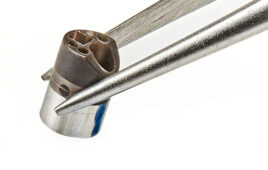To assess differences and trends in personal chemical exposure, Oregon State University researchers deployed chemical-sampling wristbands to individuals on three continents.
After they analyzed the wristbands that were returned, they found that no two wristbands had identical chemical detections. But the same 14 chemicals were detected in more than 50 percent of the wristbands returned from the United States, Africa and South America.
“Whether you are a farmworker in Senegal or a preschooler in Oregon, you might be exposed to those same 14 chemicals that we detected in over 50 percent of the wristbands,” said Holly Dixon, a doctoral candidate at Oregon State and the study’s lead author.
The study, funded by the National Institutes of Health, is published in the journal Royal Society Open Science.
This study demonstrates that the wristbands, which absorb chemicals from the air and skin, are an excellent screening tool for population exposures to organic chemicals, said Kim Anderson, an OSU environmental chemist and leader of the research team. It’s notable, she said, that most of the 14 common chemicals aren’t heavily studied.
“Some of these are not on our radar, yet they represent an enormous exposure,” she said. “If we want to understand the impact of chemical exposures, this was very enlightening.”
Anderson and her team invented the wristband samplers several years ago. They have been used in other studies, including one that measured Houston residents’ exposure in floodwaters after Hurricane Harvey.
In this study, 242 volunteers from 14 communities in four countries—the United States, Senegal, South Africa and Peru—wore a total of 262 wristbands. The Houston residents were included in the study.
Oregon State researchers analyzed the wristbands for 1,530 unique organic chemicals. The number of chemical detections ranged from four to 43 per wristband, with 191 different chemicals detected. And 1,339 chemicals weren’t detected in any wristband. They detected 36 chemicals in common in the United States, South America and Africa.
Because the wristbands don’t measure chemical levels, the study authors didn’t make any conclusions regarding health risks posed by the wearers of wristbands. But certain levels of chemical exposures are associated with adverse health outcomes.
For example, exposure to certain polycyclic aromatic hydrocarbons (PAHs) has been associated with cancer, self-regulatory capacity issues, low birth weight and respiratory distress. These chemicals were found in many of the wristbands.
Exposure to specific flame retardants, which were found in wristbands in the U.S. and South America, has been associated with cancer, neurotoxicity and cardiotoxicity.
And exposure to endocrine-disrupting chemicals (EDCs) has been linked to health effects such as low semen quality, adverse pregnancy outcomes and endocrine-related cancers.
The researchers detected 13 potential EDCs in more than half of all the wristbands.
Other notable findings in the study included:
- Consumer product-related chemicals and phthalates—a group of chemicals found in plastics and vinyl—were a high percentage of chemical detections across all study locations.
- U.S. children—11 years old or younger—had the highest percentage of flame-retardant detections compared with all other participants.
- Wristbands worn in the Houston area immediately after Hurricane Harvey had the highest mean number of chemical detections—28—compared with other study locations, where the means ranged from 10-25.
- Flame retardants were not detected in any wristbands in Africa. The absence of flame retardants in Senegal and South Africa wristbands may reflect a difference in flammability protection standards, housing materials and/or furniture used in certain Africa communities compared with communities in the U.S. and South America.
Toxicological and epidemiological studies often focus on one chemical or chemical class, yet people are exposed to complex chemical mixtures, rather than to a single chemical or an individual chemical class. The results reveal common chemical mixtures across several communities that can be prioritized for future study, Dixon said.
The study authors noted two significant limitations. They relied on a convenience sample of volunteers and did not randomly recruit participants, so the chemical exposures they reported may not be representative of all chemical exposures in the 14 communities.
Also, deployment length varied depending on the specific project. But they didn’t detect a difference in the number of chemicals detected based on how long a participant wore a wristband.




